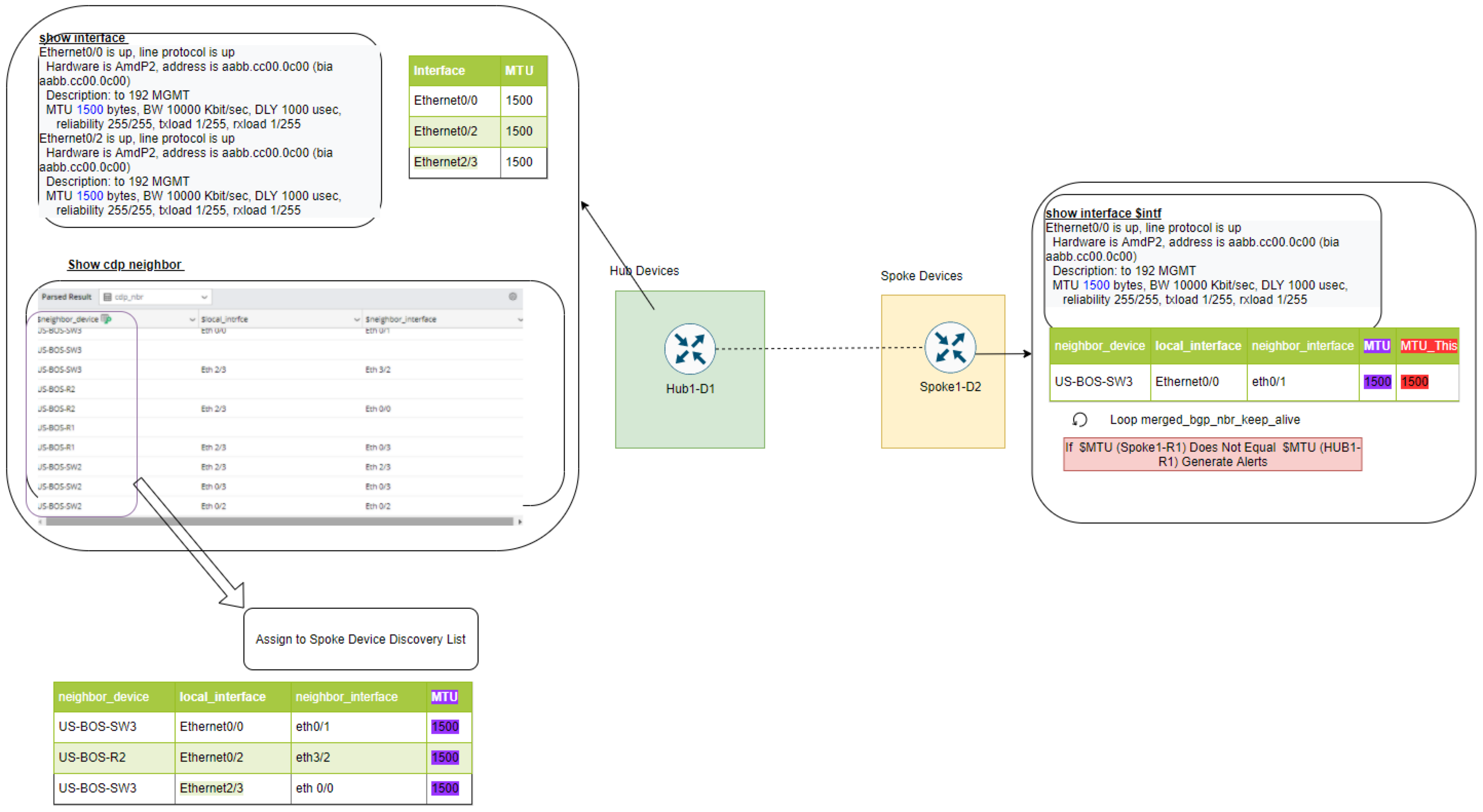Enable Neighbor Pair Replication
Enable the Neighbor pair replication if you want to check the neighbors for consistency via intents. Although you can perform the neighbor check through NIC, a large part of neighbor checks can be implemented through NIT (around 60%) and simplifies the complexity to define the neighbor check. Additionally, NIT can recur to decode and run such logic as needed.
- Open an intent and switch to Edit mode.
-
From the menu (
 ), select Replication Settings.
), select Replication Settings.
- By default, the window will open in the Intent Replication Logic Settings tab. Check the selection box of Enable Neighbor Pair Replication.

Key concepts within the NIT neighbor replication logic are as follows:
-
Device Role: Devices within the seed intent can be defined as Hub device role or Spoke device role, with the key differentiation as follows:
- At the Hub device, define the logic for calculating neighbor devices (spokes) and hub parameters, which will be passed to spoke devices through a neighbor table.
- At the spoke device, define the logic for the interactions between the hub and spoke devices, which will be duplicated for each row in the neighbor table.
- Neighbor Table: Neighbor tables are used to discover the neighbor devices for the hub and optionally pass parameters that can be used for spoke devices.
- Device Macro Variable: Hub and spoke devices may use macro variables as parameters of the show command to compare, and these parameters can come from the neighbor table for comparison.
The following image indicates the seed intent details with neighbor replication logic enabled. This example uses MTU mismatch as a network scenario to explain:

Replication Logic
The defined seed intent is used to replicate an incoming device “R1” which has two neighbors from the neighbor table, the following image explains how the cloned intent is created.

-
Qualify Devices: The device qualification defined in NIT is used to match the hub devices and normal devices, but not to spoke devices.
With “R1” as an incoming device, it will examine the NIT’s qualification and see whether it matches the definition. -
Decode Hub Devices: Decode the hub devices and normal devices automatically.
With “R1” as an incoming device, it will use Hub1-D1 to see whether Hub1-D1 matches and can be used to decode “R1”. -
Discover Spoke Devices: If the hub devices are successfully decoded, their corresponding spoke devices will be discovered according to the decoding results of the hub devices.
As “R1” is matched with the hub device, you can use the command “show cdp neighbor” to find 2 neighbors for the spoke device (“R2” and “R3”). -
Decode Spoke Devices: If spoke devices are successfully discovered, they will be decoded. The hub device and its spoke device exist in pairs, forming a dependency relationship.
With “R2” and “R3” discovered as spoke devices, they will both be used to match Spoke1-D2 to see whether there’s a match. And the spoke parameters (show interface $interface) are replaced with the real value used in the CDP neighbor. -
Replicate Intent: The logic of diagnosis in seed intent will be replicated. And the cloned intent structure is shown below:

More logic points are summarized as follows:
-
More than one hub device is supported to match the incoming devices filtered via the device qualification defined in NIT for further decoding.
- You can define cross-device diagnosis between a spoke device and a hub device in the spoke device.
- You cannot define cross-device diagnosis between a spoke device and other spoke devices.
- Devices in the seed intent must be correctly assigned with hub or spoke roles before they can match/decode the incoming devices. If no roles are configured in the seed intent, cloning the NI will result in an immediate error rather than simply filtering it out—no matching logic will be applied
- When the IBA center decodes an NIT that supports neighbor replication logic, it only decodes the hub device and obtains the command list defined in the hub device. And the IBA center will no longer decode the spoke devices.
Use Flow
The main process flow is as follows:
- Create an intent with cross-device diagnosis and enable the Neighbor Pair Replication.
- Assign roles to the seed devices and Build or Select neighbor tables on the hub device to discover the neighbors.
- (Optional) Define macro variables for hub device/spoke device.
- (Optional) Define the matching column for hub macro variable to match the interfaces in the hub and spoke devices.